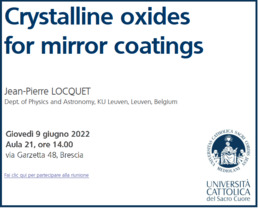- Brescia
- Dipartimento di Matematica e Fisica
- Eventi
- Nanoscale lattice dynamics: the XUV transient grating approach
Nanoscale lattice dynamics: the XUV transient grating approach

ore 11:00
Webinar
Laura FOGLIA, Researcher at Elastic and Inelastic Scattering beamlines at FERMI Elettra-Sincrotrone, Trieste, Italy
NANOSCALE LATTICE DYNAMICS:THE XUV TRANSIENT GRATING APPROACH
Thermoelastic properties in matter are mostly determined by collective lattice dynamics, which exhibit strong dependences on the characteristic length-scale. As an example, thermal transport mechanisms depend on the relative size of the heat source and the mean free path (MFP) distribution of heat carriers, primarily phonons. When the source is much larger than the phonon MFP, heat transport is diffusive and follows the Fourier’s law, mirroring a dynamic dominated by phonon collisions, while in the opposite limit phonons move ballistically. Neither description, however, holds when the source size is comparable to the MFP. The ability of measuring thermoelastic properties over a wide range of length scales thus becomes paramount for a variety of applications such as thermal barrier coatings, heat-assisted magnetic recording, nano-enhanced photovoltaics, thermoelectric energy conversion, high power nano- and optoelectronics. Most of these systems have characteristic length-scales on the order of tens of nanometers, i.e. in the so-called mesoscopic length-scale range. Yet, a full description of thermoelastic responses in this regime is still missing due to the lack of experimental techniques capable of accessing such a spatial scale [1]. In this context, the advent of free electron laser (FEL) sources has allowed to envision the application of ultrafast (sub-ps) extreme ultraviolet (XUV) radiation to TG spectroscopy. The possibility of generating, and later-on also probing, transient gratings with XUV light has been demonstrated at the FERMI FEL in Trieste using two dedicated setups: mini-TIMER [2], with visible probe, and TIMER [3,4], working fully in the XUV.
In this seminar, I introduce the technique and discuss the first results, which reveal the ability of incisively accessing vibrational modes in nanoconfined systems [5], thermal transport kinetics [4] and magnetic dynamics [6] in an uncharted length-scale range, extending down to ≈20 nm. Finally, I will outlook the future perspectives and discuss the possibility of exploiting the experimental infrastructure for the extension of other non-linear optical techniques to the XUV regime.
[1] F. Bencivenga and C. Masciovecchio, Nucl. Instruments Methods Phys. Res. Sect. A Accel. Spectrometers, Detect. Assoc. Equip. 606, 785 (2009).
[2] F. Bencivenga et al., Nature 520, 205 (2015).
[3] L. Foglia et al., Phys. Rev. Lett. 120, 263901 (2018).
[4] F. Bencivenga et al., Sci. Adv. 5, eaaw5805 (2019).
[5] D. Naumenko et al., ACS Appl. Nano Mater. 2, 5132 (2019).
[6] D. Ksenzov et al., arXiv 1 (2020).
